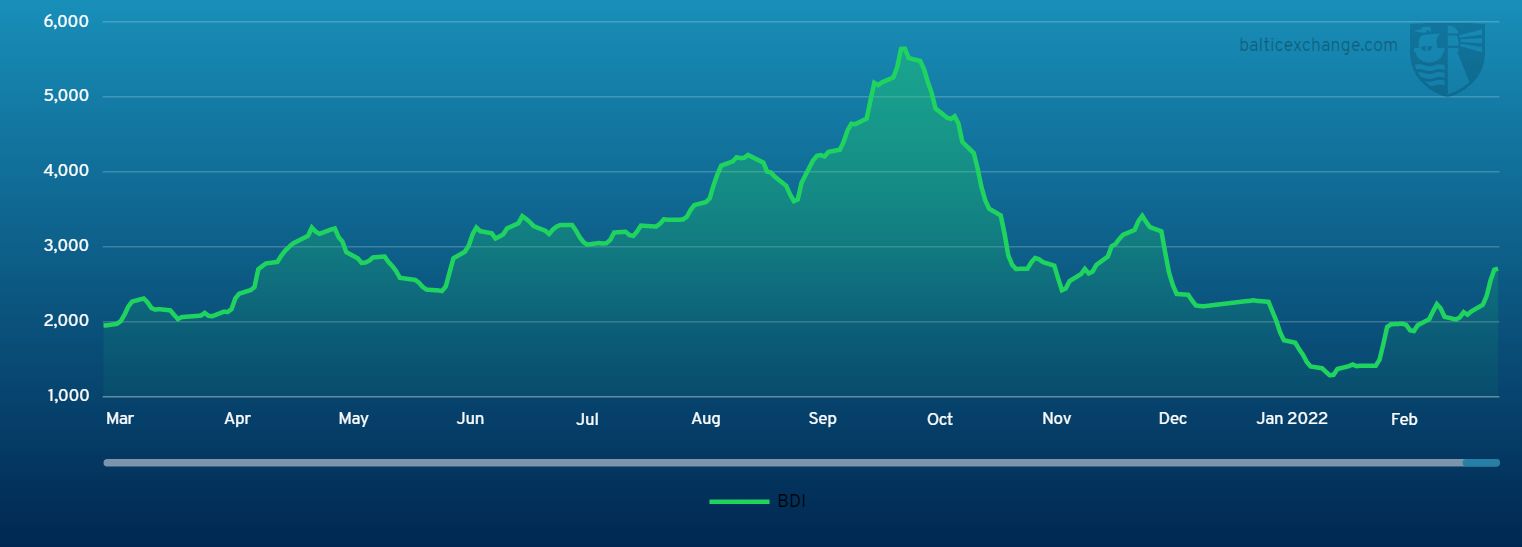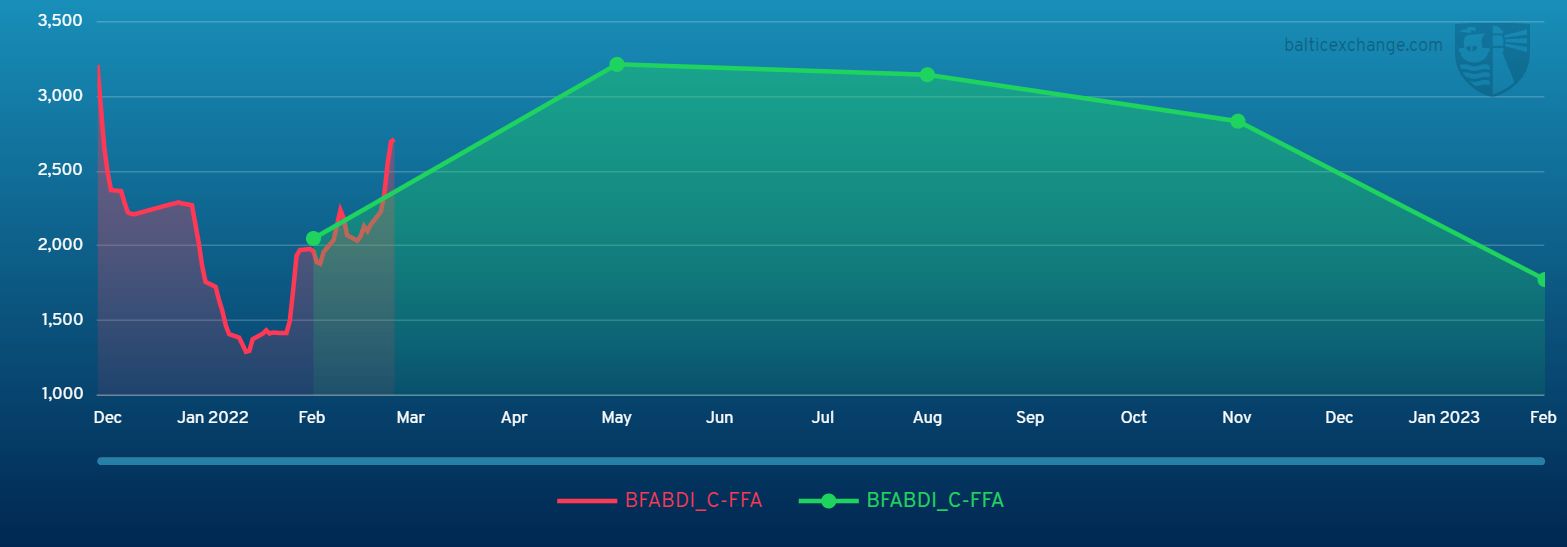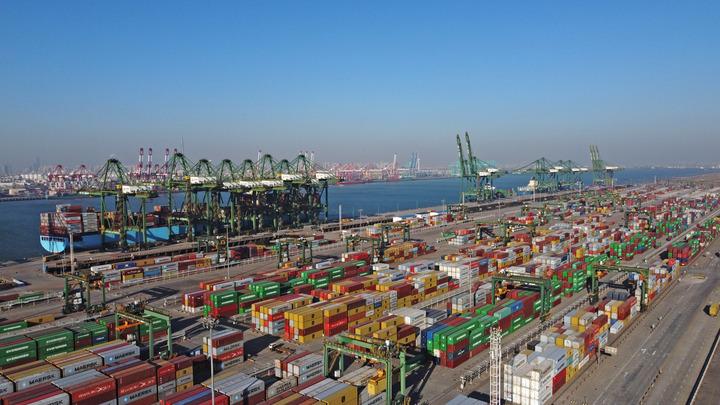BEIJING, March 14 (Xinhua) -- The Baltic Exchange has published its weekly report of the dry and tanker markets for March 7-11, 2022 as below:
Capesize
The Capesize market appeared to get caught up in the wider market rallies this week as geopolitical tensions run high, with the 5TC lifting $8,635 over the week to settle at $22,195. Tailwinds surely helped push the market higher but plenty of physical activity supported the rising rates. Fresh demand in Europe for alternative energy sources other than gas was answered by coal suppliers. Sources from as far afield as Eastern Australia sprang into life. The backhaul index C16 rose from $425 per day to $14,550, an increase of $14,125 in five days. The Atlantic basin was not left out of the action with a mix of coal and iron ore cargos that had owners raising their rates. The transatlantic C8 rose $8,625 week on week to $23,050. The transpacific round voyage, C10, closed the week $19,633 up $6,625. Bunkers continue to play havoc with voyage rates and are now responsible for a larger share of operating costs. The market remains very active and prone to surges of volatility while being very much linked to political activity amongst a rapidly changing market landscape.
Panamax
A thriving Panamax market overall and a fervent FFA market lent support to period and numerous deals were concluded. An 81,000dwt delivery India agreeing $31,750 for one year’s trading. The market in Asia got ahead of steam midweek but this eased by end of the week as markets cooled. Primarily it was an Indonesia-centric market, but heightened demand from NoPac gave support with some firm rates agreed. A new build 82,000dwt delivery Japan achieving $35,000 for a NoPac round trip the highlight. In the Atlantic, EC South America returned a two-tier market on the week. End of March ballasters from the Pacific were heavily discounted to index dates as they competed with Mediterranean tonnage diverting away from the Black Sea. Vessel in the Mediterranean conceded APS rates for EC South America round trips redelivery Continent-Mediterranean. An 82,000dwt achieving $42,500 for a trip via US east coast redelivery Continent. This resulted in the North Atlantic remain underwhelming on the week.
Ultramax/Supramax
As the Ukraine crisis entered its third week, the Atlantic was seemingly finding its feet. Owners remained reluctant to trade towards the East Mediterranean and expected a premium for such runs. From East coast South America, a 53,000dwt was heard fixed for a trip to Haifa in the upper $30,000s. For voyages from the Mediterranean it was the reverse. A 58,000dwt fixing a trip delivery Canakkale to Houston with cement at $15,750. It was overall a strong week from Asia, the continued lack of prompt tonnage and strong backhaul demand resulted in some impressive rates being reported. A 56,000dwt fixing delivery Indonesia redelivery China at $51,000. That said, as the weekend approached some brokers commented there was a slowing in pace. Period activity remained as a 56,000dwt open Mombasa mid-March was fixed for five to seven months trading at $35,000. BSI did continue its upward push, rising 353 points week on week and the 10TC weighted average finishing at $32,330.
Handysize
The BHSI continues to make gains. In Asia, brokers spoke of pressure remaining on Charterers in both the container and dry bulk markets. A 37,000dwt fixed from Japan to the Mediterranean at $60,000. A 37,000dwt open in Panjin 9-13 March fixed a trip to Chittagong at $38,000. In East Coast India, a 40,000dwt open 17-21 March fixed a trip to Safaga at $54,750. A 34,000dwt open in China 18 March fixed for two to three laden legs redelivery Singapore-Japan range at $38,000. The Atlantic rallied this week, brokers spoke of stems, which had been due to load in the Black Sea, moving to other loading regions including the US Gulf. A 38,000dwt was fixed from Savanah to the Continent at $21,000. A 37,000dwt fixed from Punta Rincon to China with a intended cargo of Copper Concentrates in the low $20,000s.
Clean
The BCTI ticked over the 1,000 mark this week as CPP tanker freight continued to climb on the majority of sectors. Extreme bunker prices are, however, putting a dampener on owners' returns. In the Middle East Gulf, the LR2s have been the hot topic. Reports of a steady flow of naphtha stems from the region, assisting TC1 to rise to WS194.29 (+42.15). The LR1s have been hot on the heels of their bigger sisters and TC5 55k Middle East Gulf / Japan has seen a 22.5 point jump to WS202.14. On a voyage west to the UK Continent, TC8 has also leaped again from $2.65m to $3.22m this week. The MRs of TC17 jumped twice, firstly from WS230 to WS260, before plateauing. Then a widely reported options voyage paying WS272.5 to East Africa looks to have played a factor in the index arriving at WS271.67 at the time of writing. West of Suez, on the LR2s TC15 80k Mediterranean / Japan has been stable at $3.2m all week.
The LR1s, TC16 60k Amsterdam / Offshore Lomé, peaked at WS155 midweek then resettled back at WS150.71. On the UK-Continent, MR freight saw a 15.83 point improvement on a TC2 run transatlantic to WS185 and similarly on TC19 +12.5 points WS192.14. Freight levels picked up again for the USG MR’s this week. TC14 38k US Gulf / UK-Continent rose to WS 198.21 (+WS21.07) and TC18 the MR US Gulf / Brazil run hopped up to WS239.29 (+20.72).
Baltic Handymax vessels have fluctuated up and down this week, which is a side effect of the Ukraine crisis, therefore creating uncertainty in the region at present and resulting in a multi-tiered market. TC9 currently sits at WS370. In the Mediterranean, TC6 30kt Skikda / Lavera has held stable on dropping a modest three points to WS281.38.
VLCC
As market participants adjust to the continuing situation in Ukraine, rates have fallen this week. However, the challenges for owners is made worse by the extreme bunker prices affecting the timecharter equivalents. For 280,000mt Middle East Gulf/USG (via Cape of Good Hope) the latest assessment is two points lower at WS22.5. In the 270,000mt Middle East Gulf/China market, rates dropped six points to WS46.5 level (a round trip TCE of minus $15,300 per day). In the Atlantic region, the 260,000mt West Africa/China route fell five points to WS45.5 level (minus $15,200 per day round-trip TCE), with the only reported fixture being a BP-operated VLCC to Exxon for a West Africa to India trip at WS48 at the beginning of the week. The 270,000mt US Gulf/China route has lost $437,500 since last week and is now valued at $5.425m (a round-trip TCE of minus $17,600 per day). However, there are reports overnight of $5.5m being on subjects for a trip to the Republic of Korea.
Suezmax
The 135,000mt Black Sea/Augusta route jumped down 31 points to WS257 (a round-trip TCE of $112,900 per day) and rates for 130,000mt Nigeria/UKC continued their tumble, losing another nine points this week to WS80 (a round-trip TCE of minus $9,300 per day). For the 140,000mt Basrah/West Mediterranean route, charterers have managed to claw back seven points and the market is now assessed at WS48.5
Aframax
The 80,000mt Ceyhan/Mediterranean market dropped 91 points to just below the WS140 level (a round-trip TCE of $6,500 per day). In Northern Europe, the rate for 80,000mt Hound Point/UKC has settled back down to WS135 (a round-trip TCE of minus $2,000 per day) - a drop of 81 points for the week. Meanwhile, rates for the Russian loading route of 100,000mt Baltic/UKC have rocketed a further 63 points to just below WS570 (a round-trip TCE of $253,100 per day) on the back of the very restricted number of vessels able - and willing - to load in Russia, discharge in Europe and that are ice-region suitable. On the other side of the Atlantic, the market slid further downwards. A 70,000mt EC Mexico/US Gulf has fallen three points to WS160 (a round-trip TCE of $3,700 per day). Similarly, 70,000mt Caribbean/US Gulf rates fell three points to the WS152.5 level (a round-trip TCE of $849 per day). For the transatlantic route, the rate for 70,000mt US Gulf/UK Continent fell 15 points to WS137 (minus $2,000 per day round-tip TCE, or a slightly more positive figure basis one-way economics).
Headquartered in London and a subsidiary of the Singapore Exchange (SGX), the Baltic Exchange publishes a range of indices and assessments which provide an accurate and independent benchmark of the cost of transporting commodities and goods by sea. These include the Baltic Dry Index (BDI), the dry bulk shipping industry's best known indicator. Published daily since 1985, this provides a snapshot of the daily spot market earnings of capesize, panamax and supramax vessel types on the world's key trading routes.

Chart shows Baltic Dry Index (BDI) during March 11, 2021 to March 11, 2022

Baltic Forward Assessment for BDI
In March 2018 the BDI was re-weighted and is published using the following ratios of time charter assessments: 40 percent capesize, 30 percent panamax and 30 percent supramax. The information is provided by a panel of international shipbrokers.
(Source: The Baltic Exchange, edited by Niu Huizhe with Xinhua Silk Road, niuhuizhe@xinhua.org)




 A single purchase
A single purchase









